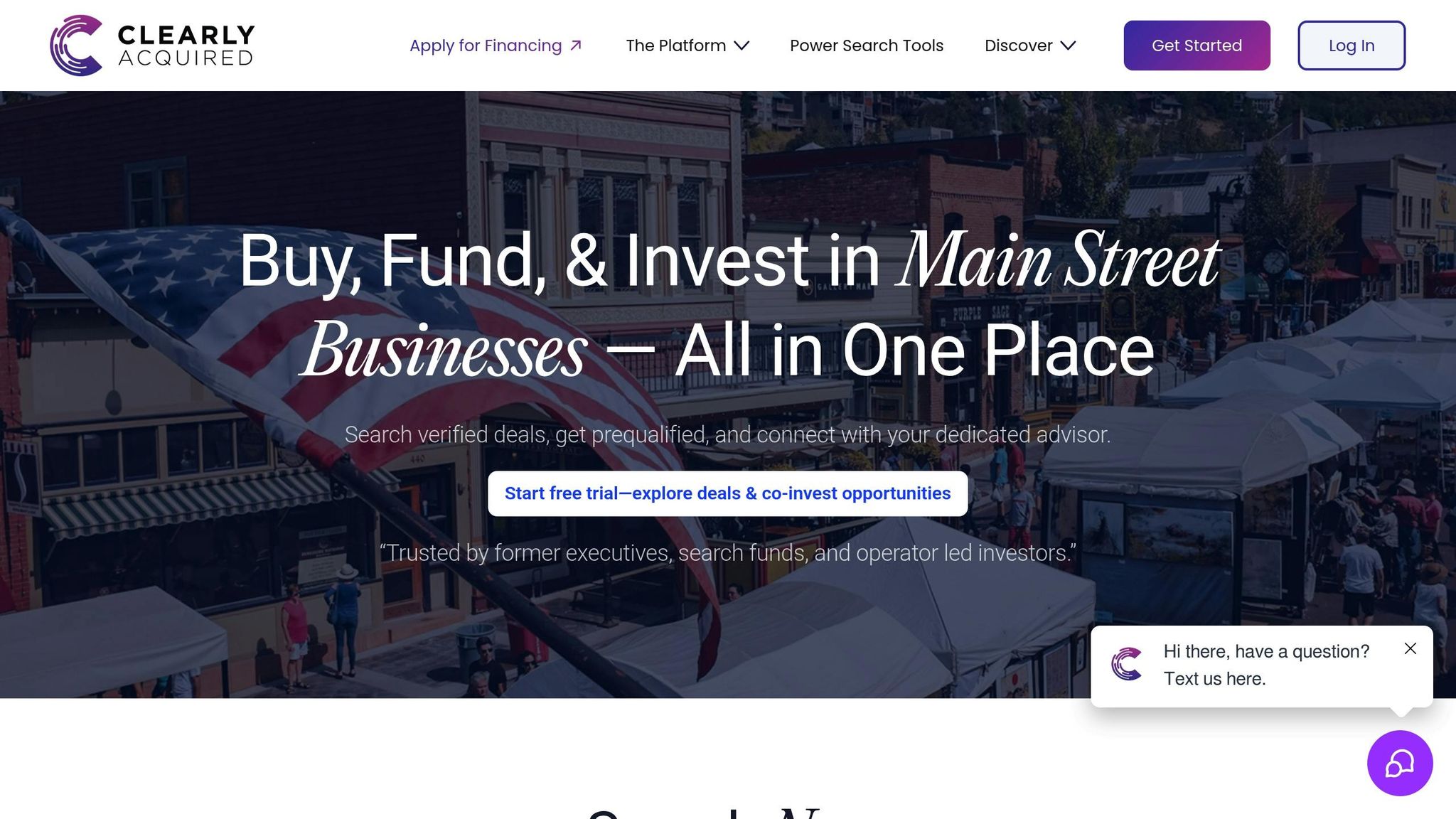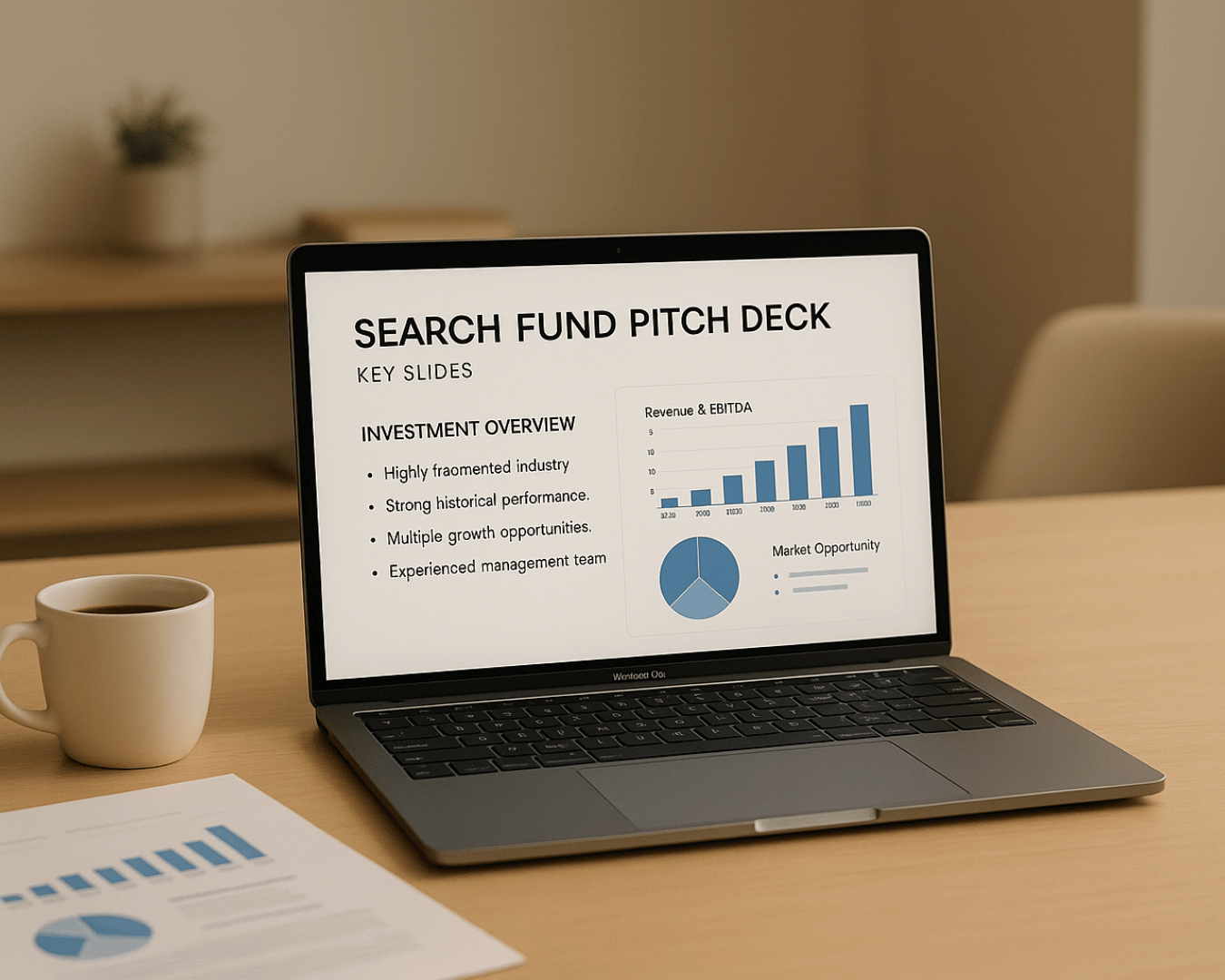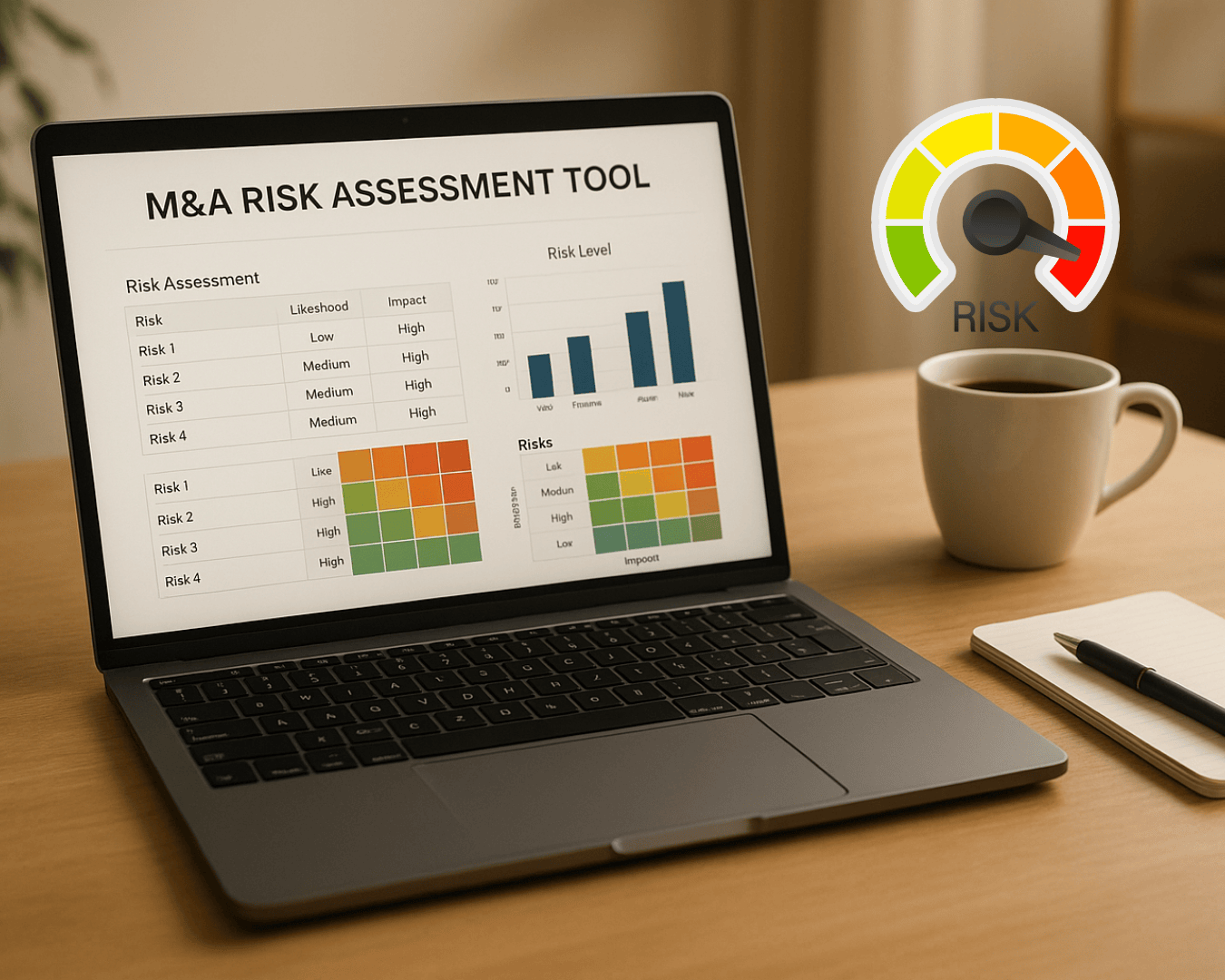Buying an established small or medium-sized business (SMB) comes with risks that can derail your investment if not managed properly. From unstable cash flow to hidden liabilities and overvaluation, these challenges can impact both the deal and the business's future success. Here's what you need to know:
- Cash Flow Issues: SMBs often face revenue volatility due to customer concentration, seasonal trends, or manipulated financials before the sale.
- Overvaluation: Sellers may inflate valuations with misleading financial metrics, creating unexpected costs post-acquisition.
- Hidden Liabilities: Unresolved debts, tax compliance problems, or legal issues can surface after the purchase.
- Cybersecurity Risks: Outdated systems and weak data protections increase the likelihood of breaches and regulatory penalties.
How to manage these risks? Conduct thorough due diligence by analyzing financial statements, tax records, and customer data. Use conservative financial forecasts, include legal protections in contracts, and work with experienced advisors. Platforms like Clearly Acquired simplify this process with tools for financial analysis, verified business listings, and funding solutions.
Key takeaway: SMB acquisitions require careful planning, risk assessment, and expert support. By addressing potential pitfalls early, you can set the foundation for long-term success.
Financial Due Diligence When Buying A Business (MADE SIMPLE)
Major Financial Risks in SMB Acquisitions
Navigating the financial risks tied to SMB acquisitions is key to making smart investment decisions. These risks can heavily influence both the success of the deal and the performance of the business post-acquisition. Identifying and addressing them early is essential for a smoother transition and better outcomes.
Cash Flow and Financial Stability Problems
One of the biggest challenges in acquiring an SMB is managing cash flow volatility. Unlike larger companies with diverse revenue streams, smaller businesses often depend on a handful of customers or seasonal trends. If a business relies on just one major client, losing them can cause serious liquidity problems.
Another issue is working capital shortfalls, which often emerge after the acquisition. Sellers may manipulate cash flow before a sale by cutting inventory levels or delaying essential expenses to make their financials look stronger. These tactics can leave new owners scrambling to address operational challenges that weren’t immediately apparent.
Seasonal businesses, like those in landscaping, tax preparation, or retail, can also surprise buyers. While annual performance might look strong, cash flow gaps during off-peak months can strain operations. Without sufficient working capital reserves, it becomes difficult to keep things running smoothly during lean periods.
Adding to the complexity are key customers with long payment cycles or frequent billing disputes, which can further disrupt cash flow.
Overvaluation and Unexpected Costs
Valuation errors are another major risk in SMB acquisitions. The lack of comparable market data and the emotional nature of these transactions often lead to inflated valuations. Sellers sometimes use unrealistic multiples or overlook factors tied directly to their own management, which may not carry over to new ownership.
Seller’s discretionary earnings (SDE) calculations can also be misleading. Questionable add-backs - such as recurring costs labeled as one-time expenses, personal expenses improperly included, or unrealistic salary adjustments - can distort the true value of the business.
Post-acquisition integration costs often exceed expectations as well. For example, outdated technology systems may require immediate upgrades, which can be particularly expensive depending on the industry. Deferred maintenance - repairs or upgrades postponed to improve short-term profitability - can also create unplanned capital requirements for the new owner.
Earnout structures, while intended to align incentives, can backfire if they’re based on overly optimistic projections. Manipulated metrics or unrealistic targets can lead to overpayment, leaving buyers in a tough spot.
Hidden Liabilities and Compliance Issues
Hidden liabilities are another area where SMB acquisitions can become financially risky. Smaller businesses often lack sophisticated accounting systems, which makes it easier for off-balance-sheet liabilities to go unnoticed. These can include personal guarantees by the previous owner, unresolved litigation, or warranty obligations that don’t show up in standard financial statements.
Tax compliance is another common issue, especially for businesses that have operated informally or taken aggressive tax positions. Problems like unpaid payroll taxes, sales tax deficiencies, or disputes over past filings can result in penalties and interest that fall to the buyer.
Employment law violations are also a frequent challenge. Misclassifying employees as contractors, failing to calculate overtime correctly, or neglecting workplace safety standards can lead to costly back-pay obligations and penalties.
Even businesses that don’t seem environmentally risky can face liabilities. Improper waste disposal, mishandling hazardous materials, or operating without required permits can lead to significant cleanup costs and regulatory fines.
Intellectual property (IP) issues present additional risks. Many SMBs lack proper trademark protections, use unlicensed software, or have unclear ownership of customer lists and proprietary processes. These gaps can lead to legal battles or force expensive licensing agreements.
Cybersecurity and Data Problems
Cybersecurity and data issues are increasingly becoming financial risks for SMBs. Many small businesses rely on outdated systems and lack strong security measures, making them prime targets for ransomware attacks and data breaches.
Non-compliance with regulations like GDPR, CCPA, or industry-specific data protection standards can result in hefty fines. Legacy software often misses critical updates, and integrating these outdated systems with modern platforms can be both complicated and costly.
Customer data quality is another concern. Inaccurate or outdated information, as well as improperly obtained marketing consent, can reduce the value of customer databases and create compliance headaches.
The absence of robust backup and disaster recovery systems leaves SMBs vulnerable to data loss. If critical business information is stored only on local servers without proper backups, a single hardware failure or security incident can cause severe operational disruptions.
Lastly, third-party vendors who have access to business systems or customer data can create additional risks. If these partners don’t follow strict security protocols, liability can shift to the new owner, adding yet another layer of complexity to the acquisition process.
How to Conduct Financial Due Diligence to Find Risks
When acquiring a small or medium-sized business (SMB), conducting thorough financial due diligence is crucial to identify and address potential risks before they turn into costly surprises. A detailed review of the business’s financial health ensures you’re not stepping into hidden pitfalls.
Analyzing Financial Statements and Tax Records
Start by reviewing 3–5 years of audited or reviewed financial statements - including profit and loss statements, balance sheets, and cash flow statements. Look for irregularities between years or any unusual spikes and dips in key metrics. Be especially cautious about revenue recognition practices, as some sellers may accelerate sales or delay expenses to make their financials appear stronger before a sale.
Cross-verify tax returns with the financial statements to spot discrepancies. Large differences between book income and tax income could point to aggressive accounting practices or compliance issues. For partnerships and S-corporations, Schedule K-1 forms can provide deeper insights into the business’s actual profitability and cash distributions.
Monthly financial data can uncover seasonal trends that annual reports may mask. Watch for declining gross margins, aging accounts receivable, or growing inventory levels - these could signal underlying operational challenges.
Cash flow analysis is particularly critical in SMB acquisitions. Calculate free cash flow by adjusting for one-time expenses, capital expenditures, and changes in working capital. Sellers often present “owner’s cash flow” or seller’s discretionary earnings, which include non-recurring adjustments. Verify these adjustments by reviewing receipts, contracts, and bank statements for accuracy.
Bank statements and cash reconciliations are essential for validating reported cash flows. Investigate unusual deposits, withdrawals, frequent overdrafts, or patterns that don’t align with the business’s operations. Credit card statements can also reveal hidden expenses that don’t appear in formal accounting records.
Finally, take a closer look at debt structures and revenue sources to assess any additional financial vulnerabilities.
Checking Debt Structure and Revenue Sources
Understanding the business’s debt profile is critical. Some obligations may not be immediately visible on the balance sheet. Request a detailed debt schedule that includes all loans, credit lines, equipment financing, and lease agreements. Be aware of personal guarantees tied to the debt, as they may not transfer to new ownership and could impact future access to credit.
Review loan agreements for covenants, interest rates, maturity dates, and change-of-control clauses, which could trigger early repayment. Similarly, examine equipment leases and real estate agreements for terms that might disrupt operations or require renegotiation.
Customer concentration is another key area to evaluate. Break down revenue by customer for the past three years. If a single customer accounts for more than 10% of total revenue, investigate further. Review the terms of these relationships, including contracts, payment terms, and transaction history.
The accounts receivable aging report can reveal collection issues. High levels of receivables over 90 days old could indicate disputes, quality problems, or inefficiencies in collections. Cross-reference this information with customer contracts to identify any unusual payment arrangements.
Recurring revenue streams are often a major factor in acquisition valuations. Verify subscription contracts, service agreements, and maintenance contracts. Pay attention to cancellation rates, renewal percentages, and price escalation clauses. Be cautious of businesses that inflate recurring revenue by including one-time services or easily canceled agreements.
Using Technology to Speed Up Due Diligence
Technology can significantly streamline the due diligence process, saving time and uncovering risks more effectively. Automated tools can extract and analyze financial data from PDFs and scanned documents, which is particularly helpful when working with smaller businesses that may lack standardized reporting.
Clearly Acquired’s platform, for example, integrates advanced due diligence tools that analyze financial statements, flag potential risks, and generate detailed reports. These systems allow you to focus on areas that require deeper investigation while speeding up the overall process.
Digital data rooms have replaced traditional physical document reviews, enabling multiple team members to access and analyze information simultaneously. Look for platforms with features like audit trails, version control, and secure access to ensure a smooth and secure review process. The ability to search documents electronically can help identify patterns or connections that might otherwise go unnoticed.
Benchmarking tools are another valuable resource. They compare the target business’s performance against industry averages and similar companies, helping you assess whether reported margins, growth rates, and financial ratios are realistic or potentially inflated.
Financial modeling software lets you test different scenarios to understand how various risk factors could impact future performance. For example, you can model the effects of customer concentration, seasonal trends, or integration costs to get a clearer picture of the potential return on investment.
How to Reduce Financial Risks in SMB Acquisitions
Once you've identified potential financial risks during due diligence, the next step is to put strategies in place to mitigate those risks. Savvy buyers rely on a mix of conservative planning, legal protections, expert advice, and a thoughtful integration approach to safeguard their investment and set the foundation for success.
Creating Realistic Financial Forecasts
Conservative financial forecasts can help shield you from unexpected challenges. Overly optimistic projections that overlook integration challenges, market fluctuations, or operational disruptions can lead to trouble after the acquisition.
To prepare, stress-test the business's historical performance by considering scenarios with modest or even declining growth. Keep in mind that some customer attrition is likely, especially if the business depends on a small group of key customers.
It's also wise to maintain a healthy cash reserve. Extra funds can cover unplanned expenses like equipment repairs, compliance issues, or temporary dips in revenue. Don’t forget to account for integration costs, such as technology upgrades, employee training, legal fees, and potential productivity slowdowns. Setting aside a contingency fund for unexpected expenses is a smart move.
When estimating future cash flows, take a conservative approach to revenue projections and carefully calculate expenses. This way, you’ll be better prepared to handle setbacks while still benefiting if the business outperforms initial expectations.
But careful forecasting alone isn’t enough - legal safeguards are another critical layer of protection.
Adding Legal Protections to Deal Contracts
Strengthen your deal contracts with provisions like indemnity clauses, escrow arrangements, and material adverse change terms. Representations and warranties insurance can also help protect against undisclosed liabilities.
Be specific when drafting these terms. For example, instead of vague language like "no material adverse changes", clearly define the conditions or thresholds that would trigger protections. Include detailed representations about key financial metrics, customer relationships, and compliance issues to ensure transparency.
Another effective tool is an earn-out structure, where part of the purchase price depends on the business meeting certain future performance goals. This shifts some of the risk back to the seller while aligning incentives.
Working with Experienced Advisors
Beyond forecasts and legal protections, expert guidance is invaluable in managing complex risks. Engaging financial, legal, and technical advisors with experience in SMB acquisitions can help you identify hidden risks and craft effective mitigation strategies.
For example, technical advisors can evaluate cybersecurity and IT infrastructure risks. This is especially important if the business needs system upgrades or enhanced security measures. A knowledgeable advisory team, like Clearly Acquired, can draw on their experience with SMB transactions to help buyers avoid common pitfalls and structure deals that prioritize long-term success.
Planning Gradual Integration
With realistic forecasts, legal protections, and expert advice in place, the next step is to plan a gradual integration process to ensure a smooth transition.
Take a phased approach to integration. Start by consolidating financial systems to gain real-time insights into cash flow, revenue, and expenses. This early step can uncover discrepancies that need to be addressed before they grow into larger problems.
Preserve key customer relationships by avoiding sudden changes, and integrate technology and staff gradually to minimize disruptions. Set clear milestones for integration activities and regularly evaluate your progress against timelines and budgets. This will help you address any issues early, preventing them from becoming significant roadblocks.
sbb-itb-a3ef7c1
Using Clearly Acquired for Financial Risk Management

Managing financial risks effectively is essential, but the right platform can transform challenges into opportunities. Clearly Acquired combines cutting-edge technology, verified deal flow, and expert guidance to help buyers handle financial risks throughout the acquisition process. By addressing key risk areas, the platform simplifies risk management through its tools and expert support, all rooted in proven due diligence and financial analysis methods.
Improving Due Diligence with Verified Deal Flow
Hidden liabilities and overvalued businesses are common risks in acquisitions. Clearly Acquired addresses these issues with verified business listings that undergo initial quality checks, reducing the chances of encountering fraudulent or misrepresented opportunities often seen in the small and medium business (SMB) market.
The platform leverages AI-powered analytics and automated NDA deployment to streamline due diligence. These tools flag discrepancies and cross-check financial data across potential deals. For example, one buyer exploring a manufacturing business used Clearly Acquired's verified deal flow to identify candidates with strong financials. During the due diligence process, the platform's AI tools uncovered mismatches between tax returns and internal statements for one prospect, revealing unreported liabilities and helping the buyer avoid a risky acquisition.
Clearly Acquired also addresses cybersecurity concerns, a growing issue given that 59% of organizations report vendor-related data breaches, with healthcare businesses making up nearly 35% of these incidents. Its secure platform ensures proper data handling and verification, helping mitigate these risks.
Getting Funding and Financing Solutions
Cash flow and valuation risks are often tied to poor capital strategies. Clearly Acquired simplifies funding by offering access to SBA loans, tailored capital structures, equipment financing, and more.
SBA loans stand out for their favorable terms and lower down payments, making them a popular choice for buyers. Clearly Acquired's loan brokerage and advisory services guide buyers through the application process, improving approval rates and reducing funding-related risks.
Through its deal management hub, buyers can model different capital structures to understand their impact on cash flow and long-term financial health. This feature allows buyers to compare debt-to-equity ratios and choose the most sustainable path, lowering the risks of overleveraging or cash flow issues that can derail acquisitions.
Whether buyers need debt, equity, or a mix of both, Clearly Acquired’s advisory team works closely with them to evaluate financial needs and match them with suitable funding options. This tailored approach ensures that the financing strategy supports long-term success rather than adding financial strain.
Using Educational Resources and Advisory Support
Knowledge gaps often lead to financial missteps, especially for first-time buyers. Clearly Acquired bridges this gap by offering a range of educational resources, including business acquisition courses, webinars, and guides on topics like financial due diligence, deal structuring, and risk management.
The platform also connects buyers with experienced professionals for advisory support, providing personalized guidance throughout the transaction process. This combination equips buyers to identify potential risks and adopt best practices for managing them. For instance, buyers can learn to analyze financial statements, evaluate working capital, and negotiate protective measures in contracts, significantly reducing the chances of costly errors.
These resources also help buyers spot financial red flags, such as unfavorable trends in current ratios or concentrated customer bases, before finalizing a deal. By integrating educational tools with expert advice, Clearly Acquired ensures buyers are well-prepared to tackle the financial challenges of acquisitions.
The platform emphasizes the importance of thorough due diligence, realistic financial forecasting, and working with seasoned advisors - key principles that align with industry standards for minimizing financial risks. With Clearly Acquired, buyers gain access to the tools and expertise they need to navigate even the most complex transactions with confidence.
Conclusion: How to Succeed in SMB Acquisitions
Key Points to Keep in Mind
Managing financial risks is at the heart of successful SMB acquisitions. The biggest hurdles often include unstable cash flow, overpaying for a business, undisclosed liabilities, and cybersecurity threats. If these issues aren’t addressed, even the most promising deals can fall apart.
Thorough due diligence is essential. This means digging into financial statements, tax records, and debt structures while using technology to spot inconsistencies. Building realistic financial forecasts and adding legal safeguards to contracts can provide extra protection. Collaborating with seasoned advisors helps buyers sidestep common mistakes.
AI tools and verified deal flow can make due diligence faster and more effective. Structuring capital wisely ensures steady cash flow after the acquisition. For first-time buyers, tapping into educational resources and expert advice can fill knowledge gaps and prevent costly errors. These foundational steps are crucial for navigating the acquisition process.
Next Steps for Buyers and Investors
To put these principles into action, integrate risk management strategies throughout your acquisition process. Clearly Acquired offers tools and resources to help, including verified listings and AI-powered due diligence.
Take advantage of educational materials like courses and webinars to sharpen your skills. Partner with experienced advisors who can guide you through financial analysis and structuring deals. Use Clearly Acquired’s deal management hub to test various capital structures and see how they might affect your long-term financial stability.
Whether you’re purchasing your first business or adding to your portfolio, focus on thorough due diligence, practical financial planning, and strong risk management. Clearly Acquired’s blend of technology, expert support, and financing options gives you the framework to make informed decisions and secure better deals - whether you’re using debt, equity, or a mix of both.
Approaching SMB acquisitions with patience, preparation, and the right tools can turn potential risks into manageable challenges. With verified deal flow, advanced analytics, and expert guidance, you’ll be well-equipped to achieve long-term success.
FAQs
What are the essential steps for effective financial due diligence in SMB acquisitions?
Financial Due Diligence in SMB Acquisitions
When acquiring a small or medium-sized business, diving deep into its financials is a must to make an informed decision. Start by analyzing the essentials: income statements, balance sheets, and cash flow reports. These documents paint a picture of the company’s financial health and help you gauge its ability to sustain operations over time. Make sure to double-check their accuracy and look for trends or patterns that could influence future performance.
Don’t stop there. Take a closer look at the company’s debts, liabilities, and legal documents, which include tax filings and previous audits. This step helps you spot any potential risks or warning signs that might not be obvious at first glance. For a deeper dive into the numbers, consider working with a financial expert to create a Quality of Earnings (QoE) report. This report breaks down the company’s earnings in detail, ensuring the data is clear and dependable.
By taking these steps, you’ll reduce risks and gain a solid understanding of the business’s financial position before proceeding with the acquisition.
What steps can buyers take to reduce cybersecurity risks when acquiring a small business?
When acquiring a small business, reducing cybersecurity risks should start with a thorough cybersecurity due diligence process. This involves examining the target company’s existing security measures, pinpointing weaknesses, and evaluating risks tied to third-party providers.
It’s also smart to take preventative steps like offering cybersecurity training for employees, conducting regular security audits, and using advanced threat detection tools. Additionally, setting up clear cybersecurity protocols and agreements for post-acquisition operations can help safeguard the business and reduce the chance of future threats.
What legal protections can help safeguard against hidden liabilities and overvaluation in SMB acquisition contracts?
When acquiring a small or medium-sized business, it's crucial to guard against hidden liabilities and inflated valuations. One way to do this is by including representations and warranties in the acquisition agreement. These clauses compel the seller to disclose any existing liabilities, such as outstanding debts, pending lawsuits, or unresolved tax obligations.
To further protect yourself, consider incorporating indemnification provisions. These provisions ensure that the seller remains accountable for any undisclosed issues that come to light after the deal is finalized, offering an added layer of security.
You might also want to include covenants in the contract. These require the seller to maintain transparency about liabilities and financial matters even as the transaction progresses. By implementing these measures, buyers can minimize financial risks, streamline the acquisition process, and approach the deal with greater confidence.
























.png)







































.png)













































